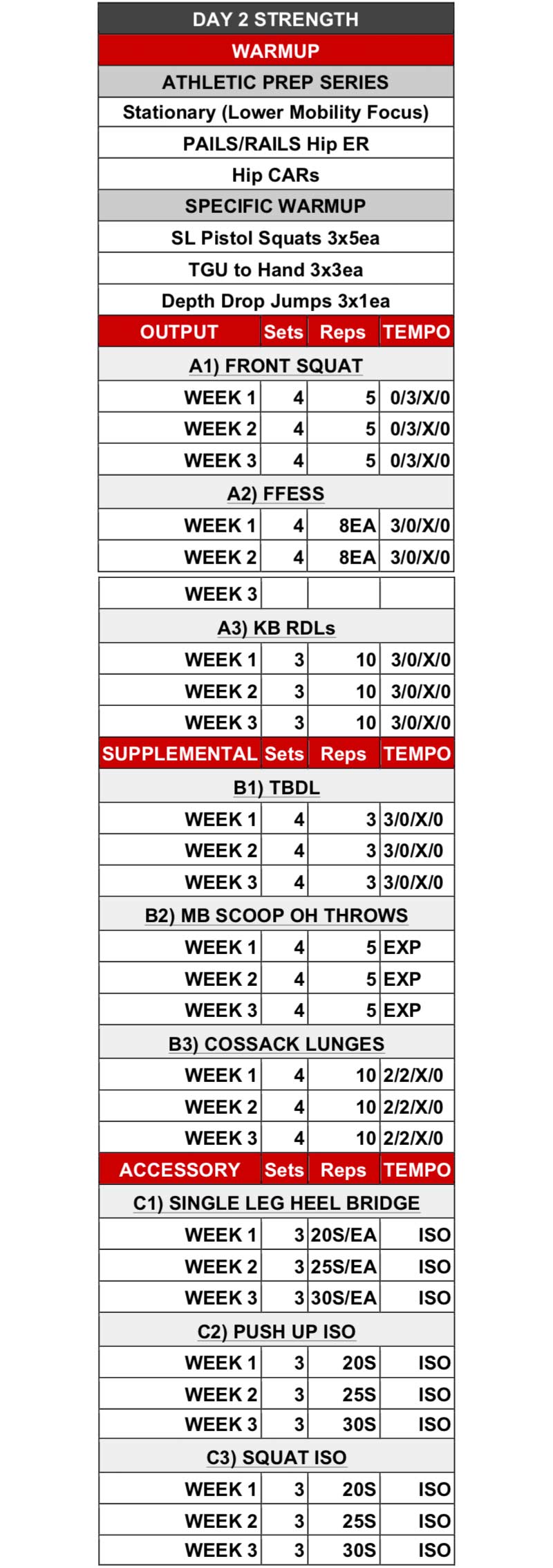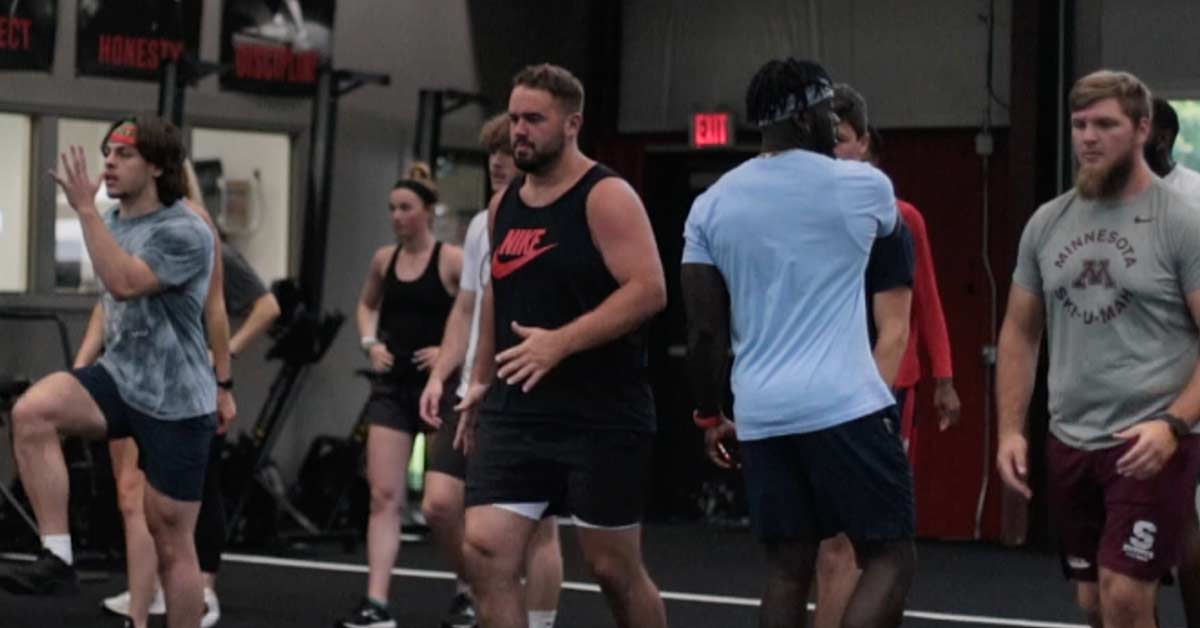In the strength and conditioning industry, coaches can train athletes at various levels, such as junior high school, high school, college, and professional. In college and professional settings, there are many resources to utilize as a strength and conditioning coach to ensure that the athletes get the best adaptations possible for optimal performance. Many facilities have more than 10 power racks, multiple specialty bars, velocity-based training technology, and more equipment for use.
In the private sector, coaches may not have those same resources due to constraints within the business, such as time, money, staff management, and facility constraints. However, athletes are still the focus, and the ability to streamline and train your athletes at a high level while inducing stress for adaptation is still the number one goal as a strength and conditioning coach.
Coaches in the private sector look to provide the best training possible for their athletes. Some facilities allow for 6–10 athletes and some facilities allow for coaches to train 15–20+ athletes at one time. This begs the question: How do you facilitate and run a large group training session in the private sector?
The principles for running a large group session require an assessment of space and facility... As stupid as it may sound, many coaches overlook the space component when planning a training session. Share on XThere are many different avenues you can take to run a large group session, depending on the facility’s resources and capacity. The principles for running a large group session require an assessment of space and facility, time constraints, resources, and command and control.
Facility Considerations
First, as a coach you must assess your space. As stupid as this might sound, many coaches overlook the space component when running a training session. Before programming even begins, you must ask yourself:
- How many athletes will be in the session?
- How many coaches do I have to run that session?
- What athletes will I have in the session (male, female, sport, etc.)?
- What do the athletes generally need in terms of training?
- Based on their needs, what space do I have to work with in the training session?
At Varsity House Gym, we train different teams with more than 30 athletes in a session. Most high school athletes generally need more strength training under heavier loads with proper technique. The focus is to improve movement quality and instill the idea that technique is more important than load, and then progress from that perspective.
As coaches, when we know how many athletes we will have and what the athletes generally need, we can determine what to program based on the space available in the facility. An example of making a training adjustment is removing Olympic lifting from the program and replacing the movement with ballistic medicine ball exercises. While I am a big advocate of Olympic lifting in high school athletes, I also understand the learning curve that is required to ensure the athletes are meeting loads that elicit the proper adaptations. That being said, it is beneficial to have a training philosophy and understand how to regress and progress the movement rather than the exercise itself.
Know the Plan
Second, programming large group sessions requires coaches to be swift, effective, and to the point in a short period of time. For the most part, most coaches do not have more than 60 minutes to get a training session in with their athletes. Attention and focus from the athletes and the coach must be high, and they must be as well organized and prepared as possible.
For the most part, most coaches don’t have more than 60 minutes to get a training session in with their athletes. One way to stay organized is by running station-based training, says @debadjuju. Share on XOne way to stay organized is by running station-based training for athletes. When coaches program stations, it allows them to control the time in which the athletes must work at each station, forces the athletes to move quicker through their workout and have a sense of urgency, and meets the athletes’ training needs when programmed correctly. The group size will be indicative of the number of stations and how long the stations will run. For a football team of 40 athletes, we will have four stations with three exercises running for eight minutes at each station.
- Station 1
- DB bench
- Inverted row
- Reverse lunges
- Station 2
- Front foot elevated split squats
- Single-leg RDLs
- Push-ups
- Station 3
- Single-arm farmer carry
- Lateral bounders
- Box jumps
- Station 4
- Reverse sled drag
- TRX rows
- Band pull-apart
The goal for lifts like these is to attack each component of athletic development (push, pull, hinge, carry, plyometric) in some way in a short amount of time. Coaches must run a cost-benefit analysis on what they want their athletes to do and how they want their athletes to do it.
If, for example, the goal is to produce more force, then we must be creative with accomplishing that goal in a timely manner. We can meet different goals of athletic development by changing and manipulating the sets, reps, and intensities via the tempo of lifts. This is not to say that coaches can’t use accommodating resistance such as chains and bands to meet those goals, but if athletes don’t have the capacity to handle those modalities, or coaches do not have the manpower to effectively coach, then we must be innovative in the way we program.

Use the Assets Available
The third component to coaching a large group session is asking what resources you have and commanding and controlling the climate you are in. Resources are the blaring elephant in the room when it comes to programming ability and bandwidth. There are coaches who will blindly program exercises and movements that require technical proficiency and fine-tuning but not have the staff to effectively facilitate the session.
Resources are the blaring elephant in the room when it comes to programming ability and bandwidth, says @debadjuju. Share on XIn a perfect world, coaches would want a 1:9 coach-to-athlete ratio in three racks. Three athletes per rack allows for the athletes to set up and break down equipment faster, learn from each other, and manage the flow of the session for the coach. If your facility has the means where there is a 1:6 coach-to-athlete ratio, then coaches can get a little more detailed with their programming. A training session with our athletes at Varsity House goes as follows:

This is a simple program that requires attention to detail both on the part of the athlete and the coaches involved. Your why behind training will always come before your how; however, you will not be able to execute higher modalities of training if you do not have the right resources or people in place.
Your WHY behind training will always come before your HOW; however, you can’t execute higher training modalities if you don’t have the right resources or people in place, says @debadjuju. Share on XWhat happens when you have athletes with different skill sets and training ages?
Given the capacity to do so, run separate concurrent programs or base the program on the lowest common denominator. Running concurrent programs looks like if a coach had a football team of 40 players—all of whom are different biological ages and training ages—that coach would want to have a beginner, intermediate, and advanced level program for the players. Coaches must understand proper progressions and regressions of movements to meet the athletes’ needs from a sports performance view. Kris Robertson, who is the Head Strength and Conditioning Coach for Simon Fraser University, wrote a standard criterion for youth development.

These benchmarks are a framework to scope your training methodology for your athletes, but the principle of meeting certain criteria before moving to the next stage holds. To run multiple programs during one session, you must understand and know what the end state is and reverse-engineer how to achieve that end goal.
Quality Coaching
Lastly, coaches need to command and always control the room and the session. There are certain intangibles that a coach needs to efficiently run a session. I’m not saying that you must be the rah-rah stereotypical strength coach who is loud and highly caffeinated, but you need to be able to capture the attention and focus of a room.
A coach must understand the general environment they are working in and the personalities they are working with to best facilitate success. For example, the stereotypical strength coach may be beneficial and needed for a football team’s culture, whereas a more reserved approach may be favorable for a men’s basketball team. The control portion relies on the second point, in which your programming is efficient and flows. A coach can command and control a room if they are well-spoken and communicative, and the flow of their session runs smoothly.
A great piece of advice when running a session is to do a mock session and set up all the equipment needed. Run through the session and identify any potential bottlenecks, says @debadjuju. Share on XA great piece of advice when running a session is to do a mock session and set up all the equipment needed. Run through the session itself and identify any potential bottlenecks in the design to ensure that the session will continue to flow. An efficient session requires a focus on the why and how of preparation and attention to detail.
Final Takeaways
Running a large group session in a college weight room does not necessarily translate to running that same session in the private sector. Depending on the private facility, a coach may be constrained by factors such as space, time, staffing, and resources.
Even when those issues are present, a coach can effectively overcome them with the proper mindset and tools. Applying the ones I’ve mentioned, I have been able to coach sessions seamlessly by understanding what my end goal is and working backward to develop a robust plan to meet that goal. My primary aim as a strength and conditioning coach is to build healthy athletes while minimizing injury risk. The principles of running a large group training session and knowing my athletes’ needs have allowed me to be successful in increasing strength and speed during training blocks.
Since you’re here…
…we have a small favor to ask. More people are reading SimpliFaster than ever, and each week we bring you compelling content from coaches, sport scientists, and physiotherapists who are devoted to building better athletes. Please take a moment to share the articles on social media, engage the authors with questions and comments below, and link to articles when appropriate if you have a blog or participate on forums of related topics. — SF




